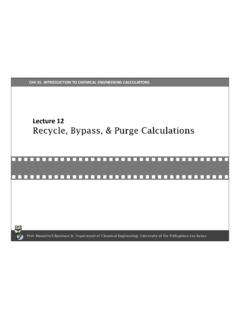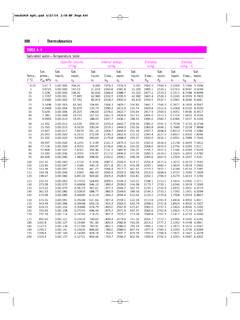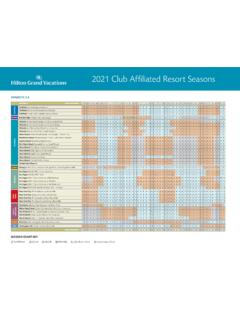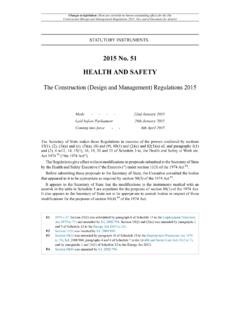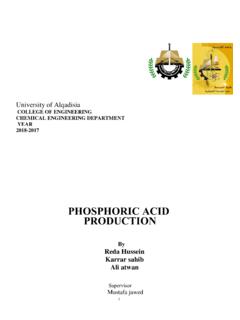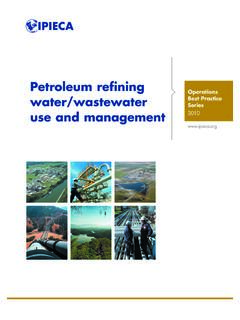Transcription of CHE 31. Introduction to Chemical Engineering
1 CHE 31. Introduction to Chemical Engineering Problem Set 3. Material Balances (Problems adopted from Elementary Principles of Chemical Process by Felder & Rousseau and Basic Principles and Calculations in Chemical Engineering by Himmelblau and Briggs) 1. Air is bubbled through a drum of liquid hexane at a rate of kmol/min. The gas stream leaving the drum contains mole% hexane vapor. Air maybe considered insoluble in liquid hexane. Use an integral balance to estimate the time required to vaporize m3 of the liquid. Ans. t = 6880 min 2. One thousand kilograms per hour of a mixture containing equal parts by mass of methanol and water is distilled.
2 Product streams leave the top and the bottom of the distillation column. The flow rate of the bottom stream is measured and found to be 673 kg/h, and the overhead stream is analyzed and found to contain wt% methanol. Calculate the mass and mole fractions of methanol and the molar flow rates of methanol and water in the bottom product stream. Ans. XM = kg CH3OH/kg YM = mol CH3OH/mol mM = x 103 mol CH3OH/h mW = x 104 mol H2O/h 3. A paint mixture containing wt% of a pigment and the balance water sells for $ , and a mixture containing wt% pigment sells for $ If a paint retailer produces a blend containing wt% pigment, for how much ($/kg) should it be sold to yield a 10% profit?
3 Ans. P = $ / kg 4. An artificial kidney is a device that removes water and waste metabolites from blood. In one such device, the hollow fiber hemodialyzer, blood flows from an artery through the insides of a bundle of hollow cellulose acetate fibers, and dialyzing fluid, which consists of water and various dissolved salts, flows on the outside of the fibers. Water and waste metabolites-principally urea, creatinine, uric acid, and phosphate ions-pass through the fiber walls into the dialyzing fluid, and the purified blood is returned to a vein. At some time during dialysis the arterial and venous blood conditions are as follows: Arterial Blood (Entering the Device) Venous Blood (Exiting the Device) Flow Rate mL/min mL/min Urea (H2 NCONH2) Concentration mg/mL mg/mL a.
4 Calculate the rates at which urea and water are being removed from the blood. Ans. Water= mL/min, Urea= mg/min b. If the dialyzing fluid enters at a rate of 1500 mL/min and the exiting solution (dialysate) leaves at approximately the same rate, calculate the concentration of urea in the dialysate. Ans. mg urea/mL c. Suppose we want to reduce the patient s urea level from an initial value of mg/mL to a final value of mg/mL. If the total blood volume is liters and the average rate of urea removal is that calculated in part (a), how long must the patient be dialyzed? (Neglect the loss in total blood volume due to removal of water in the dialyzer.)
5 Ans. 206 min 5. Seawater containing wt% salt passes through a series of 10 evaporators. Roughly equal quantities of water are vaporized in each of the 10 units and hen condensed and combined to obtain a product stream of fresh water. The brine leaving each evaporator but the tenth is fed to the next evaporator. The brine leaving the tenth evaporator contains wt% salt. Determine the fractional yield of fresh water from the process (kg H2O recovered/kg H2O in process feed) and the fraction of salt in the solution leaving the fourth evaporator. Ans. YW = ; x4 = 6. In an absorption tower (or absorber), a gas is contacted with a liquid such that one or more components in the gas is transferred in the liquid.
6 A stripping tower (stripper) also involves a gas contacting a liquid but components are transferred from the liquid into the gas. A process consisting of an absorber and a stripper is used to separate the components of a gas containing mole% CO2 and the balance CH4. This gas is fed to the absorber. A liquid containing mole% CO2 and the balanced methanol is recycled from the stripper and also fed to the absorber. The effluent gas leaving the absorber contains mole% CO2 and all the CH4 in the feed gas. The effluent solvent leaving the absorber is fed to the stripper (the same stripper that supplies the recycled CO2-methanol liquid mixture) together with a stream of nitrogen gas.
7 Ninety percent of the CO2 in this effluent solvent is removed in the stripper and the nitrogen/CO2 stream leaving the stripper passes out to the atmosphere. Methanol may be assumed to be nonvolatile and nitrogen may be assumed insoluble in methanol. Taking 100 mol/h of the gas fed to the absorber, calculate the a. Fractional CO2 removal in the absorber (moles CO2 absorbed/mole CO2 in gas feed). Ans. mol CO2 absorbed/mol fed b. Molar flow rate and composition of the liquid feed to the stripping tower. Ans. 680 mol/h; mol CO2/mol c. Molar feed rate of the gas to the absorber required to produce an absorber product gas flow rate of 1000 kg/h.
8 Ans. x 104 mol/h 7. Fresh orange juice contains wt% solids and the balance water, and the concentrated orange juice contains wt% solids. Initially a single evaporation process was used for the concentration, but volatile constituents of the juice escaped with the water, leaving the concentrate with a flat taste. The current process overcomes this problem by bypassing the evaporator with a fraction of the fresh juice. The juice is concentrated to 58 wt% solids, and the evaporator product stream is mixed with the bypassed fresh juice to achieve the desired final concentration. Calculate the amount of product (42% concentrate) produced per 100 kg fresh juice fed to the process and the fraction of the feed that bypasses the evaporator.
9 Ans. kg product per 100 kg feed; bypass fraction = 8. A stream containing wt% chromium, Cr, is contained in the wastewater from a metal finishing plant. The wastewater stream is fed to a treatment unit that removes 95% of the chromium in the feed and recycles it to the plant. The residual liquid stream leaving the treatment unit is sent to a waste lagoon . The treatment unit has a maximum capacity of 4500 kg wastewater/h. If wastewater leaves the finishing plant at a rate higher than the capacity of the treatment unit, the excess (anything above 4500 kg/h) bypasses the unit and combines with the liquid leaving the unit, and the combined streams goes to the waste lagoon .
10 If wastewater leaves the finishing plant at a rate of 6000 kg/h, calculate the flow rate of liquid to the waste lagoon (kg/h) and the mass fraction of Cr in the liquid (kg Cr/kg). Ans. kg/h, kg Cr/kg 9. In the production of bean oil, beans containing wt% oil and wt% solids are ground and fed to an extractor along with fresh and recycled streams of liquid n-hexane. The feed ratio is 3kg hexane/kg beans. During extraction, the ground beans are suspended in the liquid, and essentially all of the oil in the beans is extracted into the hexane. The extractor effluent then passes to a filter. The filter cake contains wt% bean solids and the balance bean oil and hexane, the latter two in the same ratio in which they emerge from the extractor.



